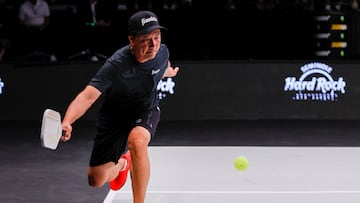What are the most common Pickleball injuries and how to prevent them
In modern sports, where physicality and competitiveness are required, pickleball appears as an option that places less strain on the body than tennis.

You’ve heard of pickleball, the unique paddle sport that blends elements from tennis, badminton, and table tennis. The court used for pickleball is similar to the one used for doubles badminton, and it features a modified tennis net at the center. It would be best if you had a paddle and a plastic ball with holes, similar to a whiffle ball, to play.
Pickleball can be played as singles or doubles, but doubles are the most common format. The game’s objective is to hit the ball over the net and into your opponent’s court in a way that makes it difficult for them to return it. Serving the ball diagonally is mandatory, and once the ball is in play, both teams can volley it back and forth until a point is scored.
One of the reasons why pickleball is so popular is its slower pace compared to tennis. This makes it an ideal sport for people of all ages and skill levels. You must have quick reflexes, excellent hand-eye coordination, and a good strategy to excel at pickleball.
How to prevent Pickleball injuries?
Pickleball is a popular paddle sport enjoyed by enthusiasts all over the world. Despite its reputation as a low-impact activity, players of all levels need to be cautious of common injuries that can occur. By taking the necessary precautions, players can continue playing the game they love without discomfort.
One of the most common injuries associated with pickleball is pickleball elbow, which manifests as pain and inflammation in the forearm tendons during play. While fractures are uncommon, players should still be aware of the risk of hip or wrist fractures due to falls or missteps on the court. It is essential to remain vigilant and aware of one’s surroundings to prevent such incidents.
Another injury to be mindful of is a rotator cuff injury, which can result from the repetitive overhead motions involved in serving and smashing. This can cause discomfort and reduced mobility in the shoulder joint. Players should also be cautious of strains or sprains to the medial collateral ligament (MCL), which provides stability to the knee joint. Sudden twisting or pivoting can stress the MCL, leading to injury. Additionally, the Achilles tendon at the back of the ankle is susceptible to strain or rupture during intense gameplay.
Preventive measures:
- Adequate warm-up exercises
- Proper footwear
- Careful footwork
In conclusion, while pickleball is generally considered a safe sport, players should not ignore the possibility of injuries. Awareness of common injuries is essential to maintain a healthy and enjoyable pickleball experience. By adopting preventive measures and practicing good technique, players can minimize the risk of injury and continue to enjoy the game they are passionate about.
Common injuries and prevention:
- Pickleball Elbow, caused by repetitive swinging. To prevent it, invest in a high-quality paddle and take breaks.
- Falling is also a concern, leading to Wrist or Hip Fractures. Improve balance and reaction time with exercises like standing on one foot.
- Rotator Cuff Injuries occur from overworking muscles. Take time off and adjust technique to prevent.
- MCL Strain can occur from twisting movements. Strengthen knee muscles with exercises and seek help from a physical therapist if injured.
- The Achilles tendon between your calf and ankle is prone to injury when playing pickleball. Symptoms include swelling, soreness, and bruising. To prevent injury, warm up properly, do strengthening and balance exercises off the court, and wear proper footwear.
Take care of your body to avoid setbacks and improve your game. Also, choose the right paddle and equipment to prevent elbow or shoulder injuries.






